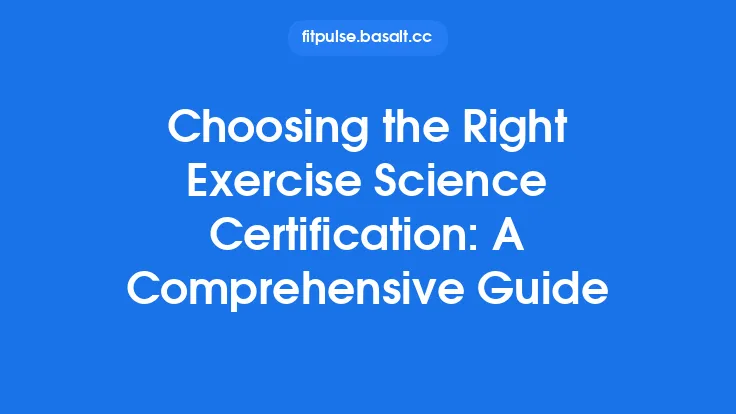The accreditation of an exercise science academic program is a rigorous, multi‑stage undertaking that ensures the curriculum, faculty, facilities, and outcomes meet nationally recognized standards. For institutions, achieving accreditation signals quality to prospective students, employers, and funding agencies, while for students it provides confidence that their education will be respected across the profession. This guide walks you through every phase of the accreditation journey, from initial preparation to ongoing compliance, offering practical tips and technical insights to help programs navigate the process smoothly.
Understanding Accreditation: Purpose and Types
Accreditation vs. Certification
Accreditation evaluates an entire educational program or institution, focusing on systemic quality and continuous improvement. Certification, by contrast, typically validates an individual’s competence in a specific skill set. While both are important, accreditation is the foundation that underpins the credibility of any certification pathway that graduates may later pursue.
Institutional vs. Programmatic Accreditation
- Institutional accreditation assesses the overall quality of a college or university and is usually granted by regional bodies (e.g., Middle States Commission on Higher Education).
- Programmatic accreditation zeroes in on a specific discipline, such as exercise science, and is awarded by specialized agencies that understand the unique demands of the field.
Key Programmatic Accrediting Agencies for Exercise Science
| Agency | Scope | Typical Standards |
|---|---|---|
| Accrediting Council for Education in Nutrition and Dietetics (ACEND) | Exercise science programs with a nutrition component | Curriculum alignment with dietetics competencies, supervised practice hours |
| Commission on Accreditation of Athletic Training Education (CAATE) | Programs that include athletic training | Clinical education, evidence‑based practice, interprofessional collaboration |
| American Council on Exercise (ACE) Academic Accreditation | Broad exercise science curricula | Core science foundations, practical lab work, faculty qualifications |
| National Association of Sport and Physical Education (NASPE) – now part of SHAPE America | K‑12 teacher preparation in physical education | Pedagogical methods, assessment strategies, community engagement |
| Accreditation Board for Engineering and Technology (ABET) (for biomechanics or kinesiology engineering tracks) | Engineering‑focused exercise science | Technical depth, lab facilities, research integration |
Choosing the appropriate accrediting body depends on the program’s emphasis—whether it leans toward clinical practice, research, biomechanics, or health promotion.
Preparing for Accreditation: The Self‑Study Phase
1. Form an Accreditation Steering Committee
- Composition: Dean or program director, faculty representatives from core areas (exercise physiology, biomechanics, nutrition, psychology), administrative staff, and a student liaison.
- Responsibilities: Oversee timeline, assign tasks, ensure documentation integrity, and serve as the primary liaison with the accrediting agency.
2. Conduct a Gap Analysis
- Benchmarking: Compare current program elements against the accrediting agency’s standards checklist.
- Data Collection: Gather quantitative data (e.g., faculty‑to‑student ratios, graduation rates, licensure exam pass rates) and qualitative evidence (e.g., faculty CVs, course syllabi, student work samples).
- Identify Deficiencies: Note any areas where the program falls short, such as insufficient lab hours, outdated equipment, or missing assessment tools.
3. Develop an Action Plan
- Prioritization: Address high‑impact gaps first—those that could jeopardize eligibility (e.g., insufficient clinical placement sites).
- Resource Allocation: Secure budget for equipment upgrades, faculty hires, or software licenses.
- Timeline: Set realistic milestones (e.g., “Update biomechanics lab equipment by Q2”) and assign owners for each task.
4. Compile the Self‑Study Report
The self‑study is the cornerstone document submitted to the accrediting agency. It should include:
- Executive Summary: Concise overview of program mission, vision, and alignment with accreditation standards.
- Program Description: Detailed narrative of curriculum structure, learning outcomes, and instructional methods.
- Faculty Profile: Qualifications, scholarly activity, professional development, and workload distribution.
- Student Support Services: Advising, career counseling, tutoring, and accessibility resources.
- Facilities and Resources: Lab spaces, equipment inventories, library holdings, and technology infrastructure.
- Assessment and Continuous Improvement: Evidence of systematic evaluation of student learning outcomes, curriculum revisions, and stakeholder feedback loops.
- Appendices: Course syllabi, sample assignments, faculty CVs, partnership agreements, and any other supporting documentation.
Best Practices for the Self‑Study
- Use a standardized template provided by the accrediting agency to ensure completeness.
- Incorporate evidence‑based language (e.g., “90 % of graduates achieved certification within six months”) rather than vague statements.
- Conduct internal peer reviews of the draft report to catch inconsistencies and improve clarity.
The Site Visit: What to Expect
Scheduling and Logistics
- Once the self‑study is approved, the accrediting agency will schedule a site visit typically lasting 2–3 days.
- The program must provide a visit agenda that includes classroom observations, lab tours, meetings with faculty, students, and administrative staff, and access to relevant documentation.
Key Components of the Site Visit
| Component | Focus | Typical Evidence Reviewed |
|---|---|---|
| Classroom Observation | Teaching methods, student engagement | Lesson plans, real‑time interaction, use of technology |
| Laboratory Tour | Equipment adequacy, safety protocols | Calibration records, maintenance logs |
| Faculty Interviews | Expertise, research involvement, mentorship | Publication lists, grant awards |
| Student Interviews | Perceived learning outcomes, support services | Survey results, anecdotal feedback |
| Administrative Review | Governance, resource allocation | Budget reports, strategic plans |
Preparing Faculty and Students
- Conduct mock observations to familiarize faculty with the evaluation criteria.
- Provide briefing sessions for students so they can articulate their experiences confidently.
- Ensure all documentation (e.g., assessment rubrics, meeting minutes) is organized and readily accessible.
During the Visit
- Be transparent and responsive; the reviewers are there to verify compliance, not to “catch” mistakes.
- Offer contextual explanations for any anomalies (e.g., a temporary lab closure due to renovation).
- Collect feedback from the review team; they often provide valuable suggestions for improvement even before the final decision.
Decision Outcomes and Post‑Visit Actions
Possible Outcomes
- Full Accreditation – The program meets all standards and is granted accreditation for a typical period of 5–7 years.
- Conditional Accreditation – Minor deficiencies are identified; the program must address them within a specified timeframe (often 12–24 months).
- Denial – Significant gaps exist; the program must undertake substantial revisions before re‑applying.
Developing a Post‑Visit Action Plan
- Document Recommendations: Create a matrix linking each recommendation to a responsible party and a target completion date.
- Implement Changes: Prioritize corrective actions, especially those tied to conditional accreditation.
- Monitor Progress: Use a project management tool (e.g., Trello, Asana) to track tasks and generate status reports for the accrediting agency.
Reporting and Renewal
- Most accrediting bodies require annual or biennial reports that demonstrate ongoing compliance and continuous improvement.
- Prepare a renewal self‑study well before the accreditation expiration date, incorporating data from the most recent assessment cycles.
Maintaining Accreditation: Continuous Quality Improvement
1. Systematic Assessment of Learning Outcomes
- Align each course with program-level competencies (e.g., “Apply evidence‑based exercise prescription for chronic disease management”).
- Use a mixed‑methods approach: quantitative assessments (exams, lab results) complemented by qualitative measures (student reflections, capstone project evaluations).
- Close the loop by adjusting curriculum based on assessment data—e.g., adding a module on wearable technology if student performance indicates a gap.
2. Faculty Development and Scholarship
- Encourage ongoing professional development (e.g., attending ACSM conferences, pursuing research grants).
- Track faculty scholarly output and integrate research opportunities into undergraduate labs, reinforcing the program’s research mission.
3. Infrastructure and Technology Upkeep
- Implement a maintenance schedule for lab equipment, including calibration logs and service contracts.
- Stay current with software licenses (e.g., motion analysis packages, statistical tools) and ensure students have access to industry‑standard platforms.
4. Stakeholder Engagement
- Conduct annual advisory board meetings with industry partners, clinical sites, and alumni to keep the curriculum aligned with workforce needs.
- Use student satisfaction surveys and exit interviews to capture emerging concerns and opportunities for enhancement.
5. Documentation and Record Keeping
- Maintain a centralized digital repository (e.g., a secure cloud drive) for all accreditation-related documents.
- Adopt a version‑control system to track changes to syllabi, assessment tools, and policy manuals, ensuring traceability for auditors.
Common Pitfalls and How to Avoid Them
| Pitfall | Consequence | Preventive Strategy |
|---|---|---|
| Insufficient Evidence – Submitting generic statements without data | Reviewers may deem the program non‑compliant | Collect and archive quantitative metrics (e.g., pass rates, employment outcomes) and qualitative artifacts (e.g., student work samples) throughout the academic year |
| Overlooking Faculty Workload Balance – Overburdened faculty leading to burnout | Decline in teaching quality and research output | Conduct annual workload analyses and adjust teaching assignments or hire adjuncts as needed |
| Neglecting Clinical Placement Agreements – Inadequate or outdated site contracts | Failure to meet required practicum hours | Establish long‑term MOUs with multiple clinical sites and review them annually |
| Outdated Curriculum – Not integrating emerging science (e.g., genomics, digital health) | Curriculum misalignment with industry standards | Implement a curriculum review cycle every 3–5 years, incorporating input from advisory boards |
| Poor Communication During Site Visit – Faculty or staff unprepared for reviewer questions | Negative impressions and potential conditional accreditation | Conduct pre‑visit rehearsals and provide a FAQ sheet to all participants |
Frequently Asked Questions (FAQ)
Q1: How long does the entire accreditation process typically take?
A: From the initial decision to pursue accreditation to receiving a final decision, most programs require 18–24 months. This includes self‑study preparation (6–12 months), site visit scheduling (2–3 months), and post‑visit remediation (if needed).
Q2: Can a program be accredited by more than one agency?
A: Yes. Some programs pursue dual accreditation (e.g., both ACE Academic Accreditation and ABET) to demonstrate excellence across complementary domains such as health promotion and engineering. However, this adds complexity and requires meeting the standards of each agency.
Q3: What role do alumni play in accreditation?
A: Alumni provide valuable outcome data (employment rates, certification success) and can serve on advisory boards. Their feedback helps demonstrate the program’s long‑term impact, a key metric for many accrediting bodies.
Q4: Is accreditation a one‑time event?
A: No. Accreditation is ongoing. Programs must submit periodic reports, undergo renewal reviews, and continuously improve to retain accredited status.
Q5: How does accreditation affect tuition and funding?
A: Accredited programs are often eligible for federal financial aid, grant funding, and may command higher tuition due to perceived quality. Conversely, loss of accreditation can jeopardize these revenue streams.
Final Checklist for a Successful Accreditation Journey
| Phase | Action Item | Status |
|---|---|---|
| Planning | Form Accreditation Steering Committee | ☐ |
| Conduct Gap Analysis against agency standards | ☐ | |
| Secure budget for required resources | ☐ | |
| Self‑Study | Draft and finalize self‑study report | ☐ |
| Collect supporting evidence (syllabi, CVs, data) | ☐ | |
| Internal peer review of self‑study | ☐ | |
| Pre‑Visit | Schedule site visit and prepare agenda | ☐ |
| Conduct mock classroom and lab observations | ☐ | |
| Brief faculty and students on expectations | ☐ | |
| Site Visit | Host reviewers, provide documentation | ☐ |
| Record feedback and recommendations | ☐ | |
| Post‑Visit | Develop corrective action plan (if needed) | ☐ |
| Implement changes and monitor progress | ☐ | |
| Maintenance | Conduct annual outcome assessments | ☐ |
| Update curriculum based on industry trends | ☐ | |
| Submit periodic compliance reports | ☐ | |
| Renewal | Prepare renewal self‑study 12 months before expiration | ☐ |
| Complete renewal site visit (if required) | ☐ |
By following this structured roadmap, exercise science programs can not only achieve accreditation but also embed a culture of continuous improvement that benefits students, faculty, and the broader health and fitness community. Accreditation, when approached methodically, becomes a catalyst for academic excellence rather than a bureaucratic hurdle.





